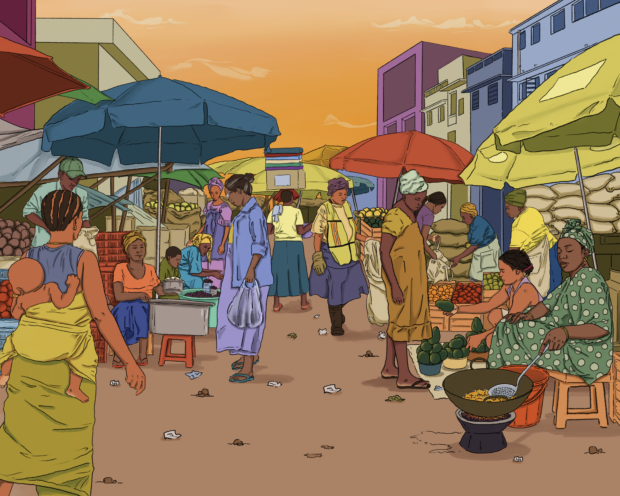Twenty years ago, during my time working at the Bill & Melinda Gates Foundation, I traveled to Bangladesh to meet Nobel prize winner Muhammad Yunus and to see firsthand what the impact of a small loan can mean for women living in poverty. With the assistance of a local translator, I interviewed family after family about the incredible value they felt in being a part of Grameen Bank. The authenticity of the women we met couldn’t have been more palpable — by all accounts they felt Grameen Bank had changed their lives for the better. But as I sat on the woven mats in homes and village meeting spots, I couldn’t help but notice that these women weren’t noticeably better off than many other people we met: their clothes were humble, their roofs were thatched, their belongings were meager. I had real doubts. Might this whole microfinance trend be more hype than it’s worth? Maybe philanthropists like Bill & Melinda Gates should focus their attention elsewhere.
It wasn’t until the last day of my visit when we were piling back into the SUV to return to the capital city that my impression drastically changed. I turned to the professional translator (who we happened to know was in the middle of his final exams in medical school back in Dhaka) to ask if he was joining us for the ride home. He kindly declined by explaining he planned to spend the weekend in this village with his mother. This young man — perfectly fluent in English and well on his way to becoming a trained doctor — was the product of a small loan that helped his family fund his education.
That’s when I understood: the impact may not be immediately visible, but having tools to take advantage of life’s opportunity can slowly – sometimes over the course of generations – help families build toward a better future.
What does this tell us about hidden impact?
The Dhaka visit reminded me that there is so much that isn’t visible to the naked eye. In that case, the impact of years of low-cost financial services paved the way for the next generation to succeed. Subsequent research by Nobel winner Esther Duflos and ethnographic insights from the Portfolios of the Poor team (Jonathan Murdoch and others) have helped to further shape our understanding of the ways in which financial services may (or may not) support vulnerable people. These targeted studies have provided crucial insights toward further improving financial tools for people and communities.
Similarly, with the work of the digital development community today, we can’t assume that impact is automatic. We must be ready to dig deeper and perhaps be ready for uncomfortable truths that get discovered along the way.
While digital public infrastructure and the digital services it unlocks offer incredible potential, there is still significant work to be done to meaningfully understand how technology is impacting people – both positively and negatively.
In the instances where such studies have been conducted, the results have been enlightening. For example, research by CGAP debunks the myth that people in poverty don’t care about their privacy and, in fact, are willing to pay in money and time for privacy-preserving financial products. Recent work by Pollicy and Fairwork has uncovered important insights into the struggles faced by women workers trying to participate in digital ridesharing and food delivery platforms across Eastern Africa. And Busara has conducted experiments to test how lifesaving information can best be delivered to refugees in the Democratic Republic of Congo.
Without greater attention to this kind of in-depth, targeted, ethnographic research, we may overlook the invisible factors that can lead to long-term benefits of digital transformation, or, equally as detrimental, allow negative factors to go unidentified – and unresolved – for years to come.
So, how do we uplift people? By listening to their stories.
Over the past year, my team and I have been exploring how we can best understand – and document – the role that technology plays in people’s lives. This work has culminated in a series of impact stories (with more to come). While a small drop in the bucket, these stories present a crucial – and underrepresented – component of people-centered digital transformation. Understanding and documenting how people are affected by technology – whether that be young women working in Ghana’s informal economy or a professional driver seeking to renew his permit in Uganda – provides needed insight into people’s lived experiences. And, more importantly, it’s a necessary step towards leveraging technology to drive maximum value for people and communities – especially those in resource-strained regions.
These stories have uncovered a deeply nuanced reality of digital transformation – one in which people are deriving tangible benefits from digital solutions but also voicing real concerns. From Mary, a young informal trader navigating Accra’s bustling marketplace, we’ve learned the importance of digital payments in helping her open a bank account and grow her business. At the same time, however, we also saw concerns from Mary and her peers around the ways in which their data could be used, leaving many of the women feeling anxious and disempowered.
We’ve gleaned similar insights in Uganda, hearing from Yusuf, a chauffeur living in the capital city of Kampala. His experience, too, showcases meaningful benefits derived from the country’s recently digitized permit registration system, including greater ease and efficiency. Yet these benefits, too, are threatened by the country’s unreliable internet coverage, which can result in frustrating technical delays. These insights from people like Mary and Yusuf provide the kind of knowledge needed to help shape future digital transformation initiatives for the better – allowing us to lean into benefits, while mitigating potential unwanted side effects.
But, to make this vision a reality, time and investment are needed.
For the digital development community, ethnographic research is still the missing piece to fully understand dynamics of digital tools and services in the local context, a gap which becomes even more striking when compared to the private sector.
In recent years, prominent telecoms companies have invested heavily into research and development (R&D) testing. Since 2000, Nokia has spent over $166 billion on R&D, and in 2021, Samsung devoted roughly $16.5 billion, a number that accounted for nearly 50% of total R&D spend across South Korea. These numbers are even higher for the top five largest tech companies, whose total combined spending reached $229 billion dollars in the past year alone.
Of course, there are so many important caveats and considerations when attempting to compare the two sectors. But it does bring up a fundamental question for the development space – what might digital transformation look like if we were to spend even a fraction of private sector time and investment on targeted, local ethnographic research to learn from the people who stand to benefit most?
Digital transformation can add incredible value to people’s lives – we just have to get it right.
In much the same way that microloans can vastly improve financial health and well-being for women in Dhaka and across the world, DPI and the innovations it unlocks have the potential to do the same for millions of people like Mary and Yusuf. The impacts aren’t always visible to the naked eye; they may even be years in the making. But sometimes, as in the case of my young translator, the unseen impacts may just be the most powerful.





